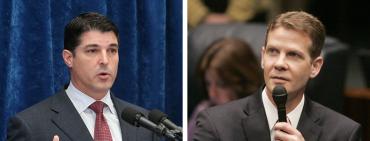
If this week’s events are any indicator, Florida’s redistricting drama is far from over even as the clock winds down to Oct. 17, when both chambers must reach some kind of agreement on Florida’s congressional maps. Ever since they left Tallahassee at the end of August, the question of which set of maps will get the rubber stamp has been looming over state lawmakers, who can’t come to a mutual agreement on which set is best for Florida voters.
Here’s a recap of where things stand:
Last week, the Florida Supreme Court sent the redistricting case back to trial courts. As part of the court order, the trial court will be able to look at both House and Senate’s map proposals. Trial court Judge Terry Lewis will hold a hearing on "remedial plans" to see which one best meets the directions of the court. The trial court must make a decision on the map by Oct. 17. The court also rejected the House’s request to extend the 100-day timeframe to come up with a new set of maps, but did say lawmakers could enact a “remedial plan.”
The Supreme Court also said state lawmakers could come back to Tallahassee to figure out an appropriate set of maps, but this week House Speaker Steve Crisafulli, R-Merritt Island, put his foot down against such a notion.
The justices acknowledged that the responsibility of making new maps primarily fell on state lawmakers, who failed to reach an agreement on the maps in August. Initially, the session seemed to show promise but negotiations between the two chambers collapsed at the 11th hour, when the House said “no” to a Senate proposal that included an amendment advanced by Sen. Tom Lee, R-Brandon.
Crisafulli’s solution? The two chambers would take up the House’s version of the maps, not the Senate’s amended set.
"Until and unless there is more direction from the Supreme Court, the most prudent course of action is to act on the map that was the joint work product of our two chambers,'' Crisafulli wrote to Senate President Andy Gardiner, R-Orlando.
Crisafulli said it would be tough for lawmakers to work out their differences unless the court decides to extend the October deadline.
“If the Supreme Court were to give us more time, we might be able to meet to hash out remaining concerns with the post-session map offered by Chair Galvano,” Crisafulli told House members.
But the House sees a map with many problems -- too many to be solved in such a short time.
Senate President Andy Gardiner still remained open to bringing the two chambers back together, but Crisafulli seemed to believe it might not be possible for state lawmakers to fix the maps because their task was simply too great.
“Maybe the burden of proof the Supreme Court placed on the Legislature during the remedial process is too great,’’ Crisafulli wrote in a letter to Gardiner. “Maybe Amendments 5 and 6 were written in such a way to be impossible for the Legislature to fulfill. Maybe the real agenda of the authors of Amendments 5 and 6 is, as many have long feared, to take the process out of the hands of elected officials and transfer the duty to the courts.”
Reach Allison Nielsen at allison@sunshinestatenews.com.


